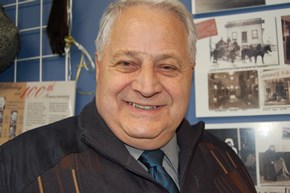Posted by Greater Sudbury Northern Life reporter Nick Stewart
An unmistakeable glint shines in Marc Lafrance's eye as he
tells how his grandfather, Adelaird, would make the arduous
trek up the Pagwa River during the First World War to purchase
raw furs in Fort Albany.
Trappers from all over Hudson and James Bay would bring furs to
trade and, after leaving behind some supplies, the founder of
the now 100-year-old Lafrance Furs would paddle back to Pagwa,
35 kilometres west of Hearst, with a couple of dozen scows
laden with bounty.
Such expeditions represent the true beginnings of the company
now headed up by Marc who, at 67, still minds the Sudbury shop
every single day, alongside his wife Claire and a handful of
employees.
A third-generation furrier, Marc insists on carrying on the
tradition laid out not only by his grandfather, but also by his
own father, Edward, who helped with the business after it moved
from their home in Chapleau to Sudbury in 1921.
In time, the reach of the family business stretched across
region, with other stores opening in North Bay in 1946 and
Sault Ste. Marie in 1952. As a result, the Lafrance family were
soon manufacturing, selling, repairing and storing fur coats
throughout the north.
It was so successful that Marc's uncle, Lawrence, finished
serving in the Aleutian Islands for the Canadian Army in the
Second World War, and then came back to help with the business.
It's a story of returning to one's roots that Marc can
understand, having repeated it himself. After spending his high
school summers helping to run the shop and accompanying drivers
on deliveries, he broke from the family trend and went on to
become a commercial pilot.
Often conducting bush flights, he would frequently fly trappers
in and out of remote areas for trapping season, often with
their families and loads of supplies.
In a back office at his unassuming Lasalle Boulevard location,
he leans forward in his chair, his tie rumpling slightly under
his sweater as he speaks of the great respect these trappers
have for the land. "The work they do is necessary to keep the
animal population under control, and they know their area well
enough to know what's too much so they really are stewards of
the land," he explained.
"A lot of people don't know that they take really good care of
the area and are really careful about what they do."
After 10 years in the skies, Marc decided to step out of the
plane and plant his feet firmly in the family business in 1973.
He hasn't looked back since.
Over time, as members of the Lafrance clan passed away or
retired, the stores were closed down. Marc still runs the sole
remaining outlet.
Some locations may be gone, but the memories still remain.
Lafrance says that, even though the Sault store shut its doors
in 1984 and the North Bay location closed a decade later,
people all over the north still seek out the company to this
day.
The depth of history has also been afforded to the Lafrance
family, which has witnessed endless changes in styles, trends
and attitudes as fur went from a near necessity at the turn of
the 20th century to a modern luxury. The strong rise in
popularity of fur through the late 1970s led to a surge of
equally strong anti-fur sentiment in the 1980s.
"People were even afraid to wear fur after a while," Lafrance
says.
Diving occasionally into a well-practised sales pitch on fur
value, Marc is clearly passionate and enthusiastic about the
many innovations the industry has seen to make the product more
lightweight.
Such efforts have begun to draw interest from younger
generations, though whether his own children may show similar
interest in the family business is another story.
With children of his own who have grown up and pursued
successful careers, Marc wistfully wonders whether one of them
may decide to follow in his footsteps and consider taking up
the family mantle.
